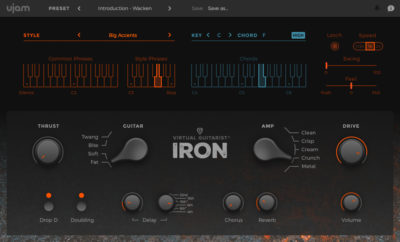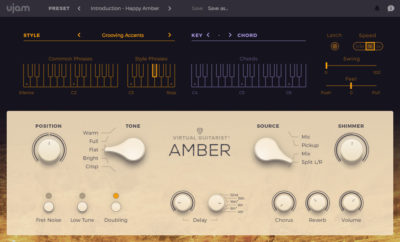New Software Review: Virtual Guitarist IRON and AMBER
When I was just a wee lad, playing in my first band in high school, we had many conversations about musical trends we knew nothing about.
One of those conversations revolved around a question posed by our drummer, who asked, “So what do you think about all these crazy ‘drum machines’? Do you think they’re actually gonna replace us drummers?”
It being the early 90s, we probably debated the authenticity of sound and feel, and scoffed at the idea that something like Boss’ Dr Rhythm could ever replace a real drummer. “I mean, can’t you hear how absurd those tom fills are?”
Fast forward to our current age of countless virtual instruments with powerful groove engines and millions upon millions of drum sounds in their banks, and that question doesn’t seem so absurd anymore.
Many artists and producers rely solely on electronic-sounding drum machines as a matter of taste, and others program amazing-sounding samples with such finesse as to fool us into thinking they were working with a real drummer all along. Plenty of us (myself included) may do either or both, depending on the project.
So when a product with a name as intriguing as Virtual Guitarist crossed my path I wondered to myself, “Damn, are us guitar players on the way out too?”
UJam, IJam, We all Jam

Virtual Guitarist offers virtual instruments aimed at aiding in songwriting, arranging, and maybe even replacing guitarists good?
I must admit that the name UJam was not familiar to me before writing this review. But a look through their website makes it clear that they have been forging a forward path into the virtual future for a while now.
With products covering everything from cloud-based composition tools, to apps promising to convert your iPhone movies into “Hollywood Moments,” it seems that UJam’s mission is to make interfacing with the virtual world as easy as possible—With the added benefit of getting a surprisingly high-quality production out of the deal.
I chose to try out IRON, a virtual electric guitarist, and also got to play around a bit with an acoustic package called AMBER.
Features and Use
Installation was as simple as one would expect. On first launching the program, you are given an interface with a split keyboard screen.
The left side, highlighted in red, has keys dedicated to “common phrases” and “style phrases.” These are rhythm patterns that are typical to the preset you choose.
The right side, marked in blue, displays your typical keyboard/note setup, where pressing down a C would play a C power chord, or pressing a C major triad would play a C major chord.
These two areas comprise the main engine of the Virtual Guitarist, but there are also a few other important features. Probably the most important of these other features is the pull down menu on the left from which you can choose a number of styles.
They range from funk to light strumming, but in general they center around heavy rock and metal. There are also two knobs placed left and right below the keyboard allowing you can choose your tone and your amplifier settings.
Other options include Drop D tuning, delay settings, double or half time (for the pattern), latch, feel (percentage of swing), chorus, reverb, and delay.
One of my key interests in trying this plugin out was to shake up my usual approach to guitar writing. I consider myself a guitarist first and foremost, and I have studied for as long as I can remember, even completing a degree in jazz performance.
As with anyone who does something for a while, you start to get a little tired of your usual tricks, and long for something to break you out of them. Would this virtual guitarist deliver that much needed shake up? Would my jazz guitar chops get sent to the trash only to be replaced by searing metal riffs?
Man vs Machine
I loaded IRON into Abelton first, hoping to kickstart the process on some fresh new compositions.
I was impressed by the breadth of styles and variations available, and wondered how much programming and thought must have gone into this program.
UJam claims that there are 6GB of samples and phrases included with this package, and the proof is in the sheer amount of choices you are presented with.
A major component of what you get with the Virtual Guitarist IRON is basically a massive library of palm-muted and power chord-type rhythm patterns pumping out whatever chord you choose.
You can change these patterns mid-measure, giving it as human of a feel as you like. However, I found the pattern-oriented riffs to be a little lacking as a starting point for a composition, so I abandoned this approach after about 15 minutes of play.
My next thought about a good application for the Virtual Guitarist was in a very “produced”-sounding, Taylor Swift-esque, modern pop song I was mixing. I had already laid down my own guitar on it, but I figured it might be cool to double the guitars with this neat little plug in.
The difference in tone jumped out immediately, along with the complete lack of feel, especially with the default settings. No worry though, I thought, I’ll just put a low, chugging power chord sequence in the bridge. For these purposes, with a little finesse and some volume adjustments, the part added just a bit of lift, and didn’t jump out as synthetic or fake.
Lastly, I tried VG out in a more country-esque song, still with the same “Swiftian” level of production, but this time, just begging for something clean and twangy. There is a clean and twangy setting on the IRON, but the presets don’t give many options for pop or country. So I went with a funk sound, which was as close as I could get.
The results were pretty much as imagined, and without the ability to hide behind distortion and low chugging frequencies, the guitar was much harder to place appropriately. The tone jumped out as harsh in context, and I was pulling down the volume to the point where it almost didn’t exist anymore.
Not all had been lost however! I did find that VG could be a great jumping off point into further creativity when taking a less conventional approach.
I started with a less-than desirable clean guitar sound and processed the hell out of it. Filters, Eventide harmonizers, delays, all the fun stuff. What I did get was a very cool rhythmic/slightly melodic line that pushed the tune along. So maybe my hope at having my creativity jump started had been accomplished, just not in the way I had initially hoped.

The AMBER acoustic guitar instrument from UJAM’s “Virtual Guitarist” line. A clean electric version called SPARKLE is also available.
My experience with AMBER however, was a little different than with IRON, and a little different than what I had initially thought it would be.
I figured that if it was hard enough to recreate searing metal riffs that get to hide behind distortion, it would be nearly impossible to recreate a believable acoustic. But I found myself loving the strumming and tonal presets behind AMBER.
This is the kind of sound and product that would be excellent for fleshing out large chorus arrangements, as they push along rhythmically just like a good acoustic track should.
Will we be obsolete?
I enjoyed my time with the IRON VG, but I find it difficult to imagine who the audience for this product may be.
As a guitarist, I know all too well about how many people “play” guitar, so there doesn’t seem to be a lack of musicians, young or old, who can’t plunk out a few power chords or open chords on their recordings with enough bare competence to rival the capabilities of Virtual Guitarist.
I also imagine that older electronic music producers may not have enough of a soft spot for guitar—in particular, the kind of metal guitar that is pre-programmed into IRON, making this a tool that few of them would be likely to add to their wishlist.
I guess that leaves us with two categories: Young, budding laptop based musicians who enjoy programming and software synths over lessons (but how many of them will fork over the money?) and non-guitarist jingle writers, who need to turn around reasonably good commercial spots or production sketches quickly and easily.
AMBER, on the other hand, felt far more useful to me, both as a songwriting aid and an arrangement tool for DAW-based producers.
So will the VG will put us guitarists out of business? I think that at this point the answer is no. But I still really admire UJam and what they’re doing.
Although Virtual Guitarist is not much of a threat to actual guitarists for the time being, this may be the start of a trend in which the software only gets better and better from here.
I mean, hell, this is eons beyond the guitar presets on those 80’s casios, so we’re definitely making progress. I hope that UJam keeps working in the field and on the projects they do, and I can’t wait to face off against a future version of the VG in an epic duel for the salvation of all musician-kind.
Please note: When you buy products through links on this page, we may earn an affiliate commission.






